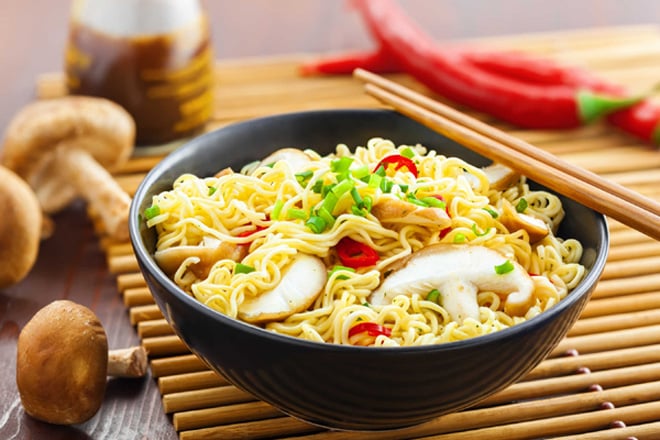Instant Noodles Ingredients
Typically, one pack of instant noodles contains about 320 calories, while a bowl of regular rice contains about 200 calories. Instant noodles are made from wheat flour, cooking oil, yellow color from fresh turmeric powder, salt, flavor enhancers, foam-forming agents, and various additives to enhance the flavor and aroma. Therefore, instant noodles only contain refined carbohydrates (bad carbs), trans fat (harmful saturated fat), salt, MSG, flavor enhancers, and lack fiber, vitamin A, C, B12, etc.
In addition, instant noodles are often fried in high-temperature oil, which destroys nutrients and vitamin B. This process also creates a lot of metabolized fat, increasing blood cholesterol and insulin resistance, leading to a sudden increase in blood sugar levels.

The glycemic index (GI) of instant noodles is 47, not high, but the longer it is cooked, the higher the GI and the effect on blood sugar levels. In addition, the glycemic load of noodles is 18.8, which is average, but eating too much can cause a sudden increase in blood sugar levels.
Moreover, just by eating one pack of instant noodles, the sodium intake into the body is higher than recommended.
Therefore, regularly eating instant noodles will make you feel full of energy but lack the necessary nutrients. People with diabetes who consume instant noodles may experience a sudden increase in blood sugar levels, affecting their health. In addition, diabetic patients are also prone to complications such as high blood pressure, kidney problems, and cardiovascular diseases.

3 Ways to Eat Noodles without Increasing Blood Sugar Levels and Effective Weight Loss
Choose Noodles Made from Various Grains
People with high blood sugar or diabetes should choose noodles made from various grains. For example, whole wheat noodles, oat noodles, barley noodles, etc. The glycemic index of whole wheat noodles is only 37, which is very useful for weight loss and controlling blood sugar levels after meals.

Eat Noodles with Various Other Foods
You should eat noodles with a lot of vegetables, at least a 1:1 ratio or even more. While cooking noodles, you can also mix them with some protein-rich foods such as eggs, meat, tofu, shrimp, etc. A mixed meal will have a lower glycemic index compared to just eating noodles, which can slow down the process of increasing blood sugar levels after meals.
Cook Noodles Cleverly
You should boil the noodles until they are half cooked, then remove them and put them in cold water. When the noodles are completely cool, continue boiling them in a pot. This will help make the noodles chewier.
With this cooking method, the digestion rate is relatively slow after eating, which is beneficial for controlling the increase in blood sugar levels after meals.
2. Eat noodles with plenty of vegetables and protein-rich foods. This creates a mixed meal with a lower glycemic index, slowing down the increase in blood sugar levels after eating.
3. Cook your noodles cleverly: boil them until half-cooked, then soak them in cold water. When they’re cool, boil them again. This makes the noodles chewier and slower to digest, helping to control blood sugar spikes after meals.



































